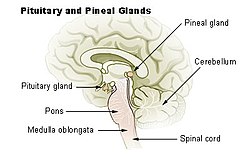Pituitary gland

The pituitary gland or hypophysis (cerebri) (Greek: υπόφυση ipófissi, "the plant attached below", Latin: glandula pituitaria) is a hormone gland and plays a superordinate role in the entire hormone system. In particular, it regulates processes such as reproduction, growth and metabolism. The pituitary gland is located in the middle of the head at nose level on the bony part of the skull base known as the sella turcica and is divided into the anterior pituitary lobe, the so-called adenohypophysis, which has developed from the so-called Rathke's pouch of the oral cavity and is therefore not a part of the brain, and the posterior pituitary gland, also known as the neurohypophysis, which is connected to the hypothalamus of the brain by the pituitary stalk (infundibulum). In the α-cells of the anterior pituitary, the growth hormone somatropin is produced during sleep, most during puberty.
According to Rudolf Steiner, the pituitary gland, together with the epiphysis, is essentially involved in memory formation. It also plays an important role in meditation, as Steiner shows with the hexagram exercise:
„When a soul begins to meditate in this way, an organ in the physical body begins to develop: the pituitary gland. In the average person, the pituitary gland is an organ barely the size of a cherry stone behind the pineal gland. But it contains disproportionately great powers. It regulates, in fact, the proper structure of the body in terms of its size. In the so-called giants that are shown around, there is a disease of the pituitary gland. In some way or other, the forces set in motion by it must be acted out. When the meditator begins to work on himself, forces are awakened in the pituitary gland. From the mucous gland, the organic construction from the chaos of sensations to the astral body takes place. When the pituitary gland flows around the pineal gland with golden threads, then the time has come when the transformation of the astral body into the spirit self, into Manas, has progressed so far that now the etheric body can be transformed into the Buddhi.“ (Lit.:GA 264, p. 196)
In the future the pituitary gland, together with the pineal gland, will form the so-called etheric forebone, a kind of second spinal column, which in the future will be formed at the front of the human being as a counterpart and complement to the backbone, with which it will later join to form a closed system. Through spiritual training, if it is done in the right way, this development is already anticipated to a certain extent today (Lit.:GA 266b, p. 119).
Literature
- Rudolf Steiner: Grundelemente der Esoterik, GA 93a (1987), ISBN 3-7274-0935-5 English: rsarchive.org German: pdf pdf(2) html mobi epub archive.org
- Rudolf Steiner: Zur Geschichte und aus den Inhalten der ersten Abteilung der Esoterischen Schule 1904 bis 1914, GA 264 (1987), ISBN 3-7274-2650-0 English: rsarchive.org German: pdf pdf(2) html mobi epub archive.org
- Rudolf Steiner: Aus den Inhalten der esoterischen Stunden, Band II: 1910 – 1912, GA 266/2 (1996), ISBN 3-7274-2662-4 English: rsarchive.org German: pdf pdf(2) html mobi epub archive.org
 |
References to the work of Rudolf Steiner follow Rudolf Steiner's Collected Works (CW or GA), Rudolf Steiner Verlag, Dornach/Switzerland, unless otherwise stated.
Email: verlag@steinerverlag.com URL: www.steinerverlag.com. Index to the Complete Works of Rudolf Steiner - Aelzina Books A complete list by Volume Number and a full list of known English translations you may also find at Rudolf Steiner's Collected Works Rudolf Steiner Archive - The largest online collection of Rudolf Steiner's books, lectures and articles in English. Rudolf Steiner Audio - Recorded and Read by Dale Brunsvold steinerbooks.org - Anthroposophic Press Inc. (USA) Rudolf Steiner Handbook - Christian Karl's proven standard work for orientation in Rudolf Steiner's Collected Works for free download as PDF. |
